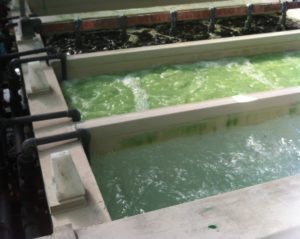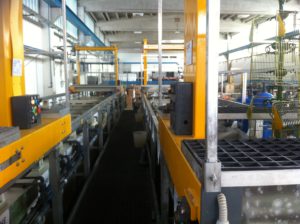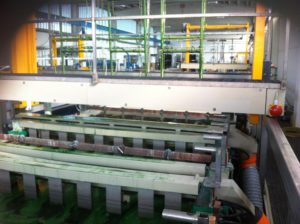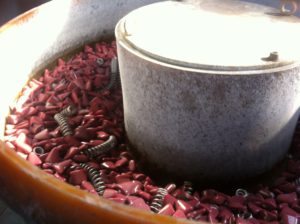 With headquarters at Gargallo, in province of Novara, APS di Creola e C. Snc is a family-owned company specialized in stainless steel treatments: electropolishing, tumbling and passivation.
With headquarters at Gargallo, in province of Novara, APS di Creola e C. Snc is a family-owned company specialized in stainless steel treatments: electropolishing, tumbling and passivation.
The advantages of electropolishing
The electrolytic polishing has a double aesthetical and technical purpose. From the aesthetical point of view, it replaces the mechanical polishing carried out by brushes in the machining of small metal parts or manufactured goods with extremely irregular shape. From the technical point of view, it improves the characteristics of the treated surface compared to the mechanical polishing, like the absence of micro-grooves and organic contaminants (ex. Polishing pastes), high passivation degree and attainment of easily washable and sanitized surfaces. «This is the most interesting aspect of the electrolytic polishing, which is the treatment on which our company specifically bets» underlines Ivan Creola, owner of APS di Creola e C. SNC together with his brother Luca.
Application sectors
The application fields of electropolishing are endless and they range from the base industry to consumer goods: from the food to the pharmaceutical industry, from shipbuilding to outdoor lamps. «In general, we work hard on the final product» adds the owner.
 Thanks to the property of not retaining contaminants and therefore being easily sanitized, the electropolished steel is widely used in food and pharmaceutical industries for the construction of plants, conveyors, trucks, tanks, reactors and all necessary items. In the shipbuilding sector, the electropolished steel is replacing the boat components made of chrome-plated metal or brush polished steel, like handrails, railings and instruments. This thanks to the high degree of passivation and then of resistance to corrosion, which in the marine environment is one of the main causes of deterioration of the aesthetical-functional aspect. In the domestic ambit, the electropolishing is used on cutlery and cookware as alternative to the mechanical brushing and as further finishing after brushing but also as surface preparation to receive a galvanic treatment, for example gold plating.
Thanks to the property of not retaining contaminants and therefore being easily sanitized, the electropolished steel is widely used in food and pharmaceutical industries for the construction of plants, conveyors, trucks, tanks, reactors and all necessary items. In the shipbuilding sector, the electropolished steel is replacing the boat components made of chrome-plated metal or brush polished steel, like handrails, railings and instruments. This thanks to the high degree of passivation and then of resistance to corrosion, which in the marine environment is one of the main causes of deterioration of the aesthetical-functional aspect. In the domestic ambit, the electropolishing is used on cutlery and cookware as alternative to the mechanical brushing and as further finishing after brushing but also as surface preparation to receive a galvanic treatment, for example gold plating.
«The electrolytic polishing can be required in presence of grooves where the mechanical polishing has no access, for instance in the pot handles decorated with satin-finish effect. In the pharmaceutical industry, the electrolytic cleaning need is clear » comments Creola.
To be competitive, we pursue the highest automation and we try to keep the machine fleet efficient with controls every six months.
TREATMENTS IN DETAIL
The galvanic electropolishing, or anodic cleaning, is a stainless steel cleaning and decontamination process. The treatment is  based on the controlled surface corrosion, by means of an electrolyte (polishing bath) and of a current flow. Electropolishing baths are composed by a concentrated mixture of acids (sulphuric and phosphoric) and additives of organic nature. The organic part of the bath is aimed at creating an insulating anodic film, more consistent in grooves and almost null in peaks where, with the combined action of acids and current, the metal is brought into solution attaining a peak lowering and consequently, a surface levelling.
based on the controlled surface corrosion, by means of an electrolyte (polishing bath) and of a current flow. Electropolishing baths are composed by a concentrated mixture of acids (sulphuric and phosphoric) and additives of organic nature. The organic part of the bath is aimed at creating an insulating anodic film, more consistent in grooves and almost null in peaks where, with the combined action of acids and current, the metal is brought into solution attaining a peak lowering and consequently, a surface levelling.
The passivation is a treatment that allows restoring the original stainless specifications of a degraded stainless steel item. The immersion into passivating baths allows not only extending the piece service life but also removing the eventual traces of the previous machining, especially mechanical ones. For this reason, the treatment is also called decontamination. «Passivation is on high demand in the lighting technique industry where the satin finish must remain unchanged» explains Creola.
The tumbling (or  rumbling) finally is a mechanical machining of surface finishing, generally used for the mechanical removal of substrate residues, especially burr, due to processes like moulding and casting. It is highly suitable for the surface finishing of a high number of small-size parts. The process occurs by rolling and collision of parts in a barrel (tumbler) and eventually of abrasive shaped material, which speeds up the operation. The rotation speed of the tumbler influences the machining speed. The tumbling can be executed also through immersion into liquid to prevent chemical attacks. This machining causes generalized size variations on the piece surfaces ranging from 2 to 20 μm.
rumbling) finally is a mechanical machining of surface finishing, generally used for the mechanical removal of substrate residues, especially burr, due to processes like moulding and casting. It is highly suitable for the surface finishing of a high number of small-size parts. The process occurs by rolling and collision of parts in a barrel (tumbler) and eventually of abrasive shaped material, which speeds up the operation. The rotation speed of the tumbler influences the machining speed. The tumbling can be executed also through immersion into liquid to prevent chemical attacks. This machining causes generalized size variations on the piece surfaces ranging from 2 to 20 μm.



